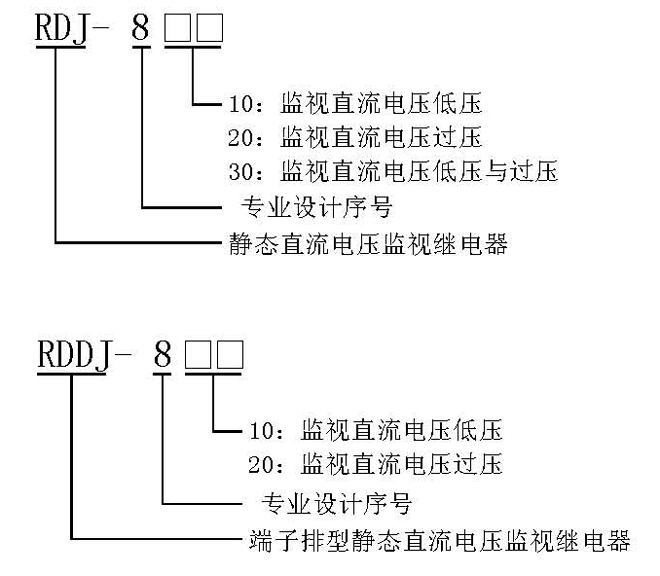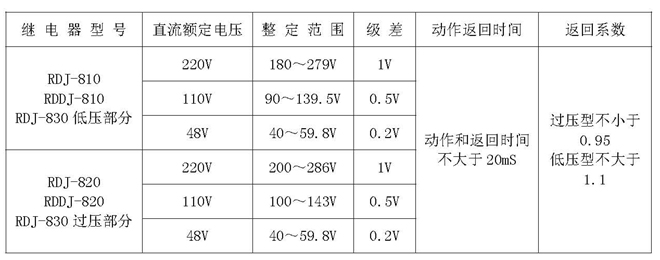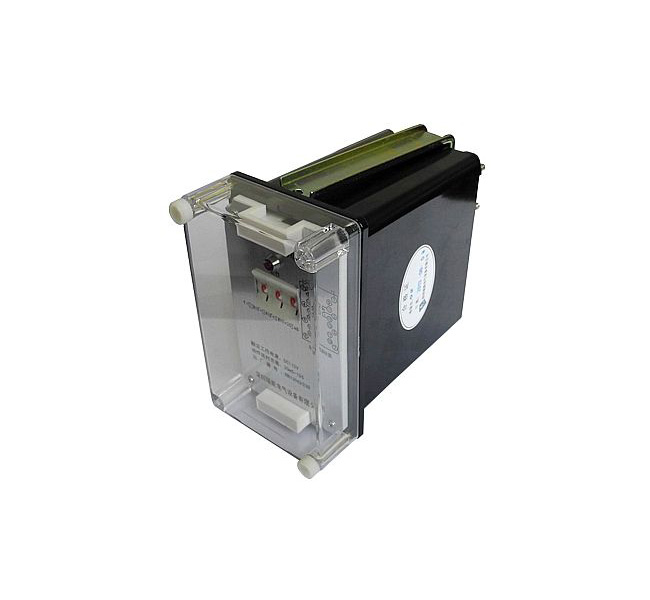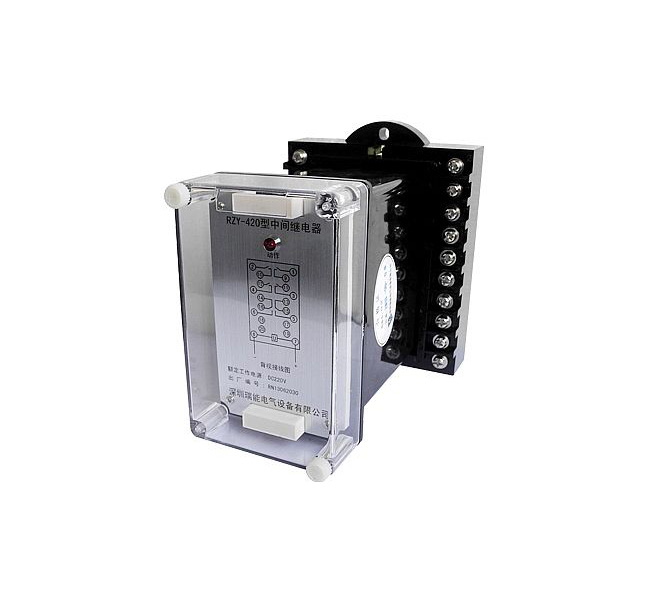1 Application range
This series of relays are used to monitor the voltage of the DC system, judge the voltage of the DC system is too low or the voltage is too high, and send an alarm.
2 Model definition

3 Working principle and main performance
3.1 Working principle
The DC voltage is converted to the voltage required by the relay through a step-down, and then filtered through a band-stop filter to remove 150HZ harmonics; and then sent to the tuning loop; the tuning loop changes the setting value by changing the amplification factor of the operational amplifier; the output voltage of the tuning loop UZ is sent to the level detector for comparison with the comparison voltage UB; the output of the driving relay J is activated.
3.2 Relay action process (take AK11 structure as an example):
3.2.1 For RDJ-820 over-voltage DC voltage monitoring relay, under normal operating conditions UZ<UB, relay J will not operate, and the moving contacts 1-3 and 7-19 will be disconnected; moving breaking contacts 5-7, 3-17 closed. In the case of a fault, UZ>UB, relay J will act, moving on contacts 1-3, 7-19 will be closed; moving break contacts 5-7, 3-17 will be open.
3.2.2 For the RDJ-810 low-voltage DC voltage monitoring relay, under normal operation conditions UZ>UB, relay J does not operate, and the moving contacts 1-3 and 7-19 are disconnected; the moving breaking contacts 5-7, 3-17 closed. In the case of failure, UZ<UB, relay J will act, and the moving contacts 1-3 and 7-19 will be closed; the moving breaking contacts 5-7 and 3-17 will be disconnected.
3.3 Main performance
3.3.1 The use of high-efficiency and high-performance integrated circuits and components, with stable performance, high reliability, high precision of the action value, small discrete value, wide setting range, fast action and return speed, good return coefficient, low transformer burden, The advantages of vibration resistance, anti-interference and high insulation level.
3.3.2 The protection setting value is set by the dial switch on the relay panel, and the setting calculation formula is indicated. The setting is intuitive and convenient, and the debugging is simple and convenient. No adjustment is required on site.
3.3.3 The relay has action indicator lights.
4 Technical conditions
4.1 Environmental reference conditions
Environment temperature: 20±2℃
Relative humidity: 45%~75%
Atmospheric pressure: 86~106KPa
4.2 Normal use conditions
Ambient temperature: -10℃~+50℃
Relative humidity of environment: not more than 90%
Atmospheric pressure: 80~110KPa
Limit temperature during storage and transportation: -25℃~+70℃
The altitude of the place of use: no more than 2500 meters
The surrounding medium of the use environment has no explosion hazard; it does not contain corrosive gas; the concentration of conductive dust contained should not reduce the insulation level below the allowable limit value.
Reliable power supply.
4.3 Rated parameters
DC rated voltage: 220V; 110V; 48V; allowable voltage fluctuation range: 0.8 to 1.2 times the rated voltage
4.4 Characteristic parameters

4.5 Maximum power consumption of the DC circuit: Under the condition of rated voltage 220V, it is less than 3W in static state and less than 8W in operation.
4.6 Maximum capacity of contacts:
Cut-off load capacity: DC 250V or less, τ=5ms, inductive load 50W, resistive load 150W;
AC below 250V, load 1200VA;
Allow long-term connection current: 5A.
4.7 DC circuit overload capacity: continuous work under 1.2 times the rated voltage.
4.8 Insulation resistance: Use an open-circuit voltage 500V megger to measure the insulation resistance between the exposed non-charged metal parts or shells of the relays connected to each conductive terminal and should not be less than 10MΩ.
4.9 Insulation withstand voltage: each lead-out terminal to the housing locking screw can withstand a power frequency voltage of 2000V, and the same group of contacts can withstand a power frequency voltage of 1000V, which lasts for one minute without breakdown.
4.10 Anti-interference performance: meet the national GB6162-85 "Electrical Interference Test of Static Relays and Protection Devices" standard.
4.11 Electrical life: In the DC250V circuit, cut off the current τ=5ms, 50W, more than 104 times.
4.12 Mechanical life: The contact is 3 million times in no-load state.
5 Structure type (see the relay structure size diagram for details)
5.1 Embedded board rear wiring structure AK11, AP11 and protruding board front wiring AQ11 rear view wiring diagram (subject to company product samples)
5.2 JK-1/8 structure rear view wiring diagram (subject to company product samples)
5.3 DZ-1 structure terminal block type terminal wiring diagram (subject to company product samples)
6 Use
6.1 Before energizing the relay, confirm whether the voltage level and current value of the connected relay are consistent with the actual parameters, otherwise the relay may be damaged; check whether the relay is damaged during transportation and storage, and the relay screw fasteners should not be loose; There are damaged parts, please contact us to replace them.
6.2 According to the formula on the relay panel, use the dial switch to set.
Setting formula: U< is low voltage; U> is over voltage
220VDC: U<=[10□+□+180]V
U>=[10□+□+200]V
110VDC: U<=0.5[10□+□+180]V
U>=0.5[10□+□+200]V
48VDC: U<=[2□+0.2□+40]V
U>=[2□+0.2□+40]V
7 Ordering instructions
When ordering, please state the relay model, specification, quantity, DC rated voltage, setting range, structure and other requirements.











